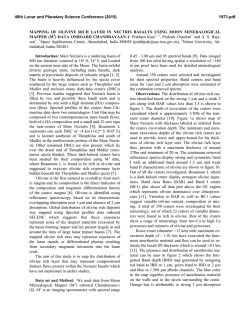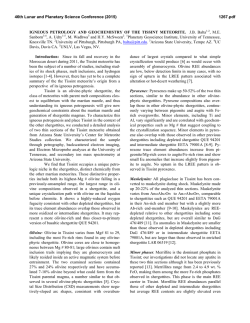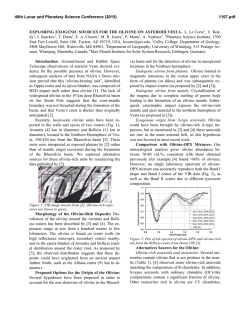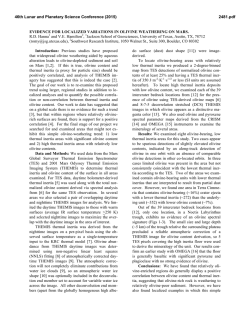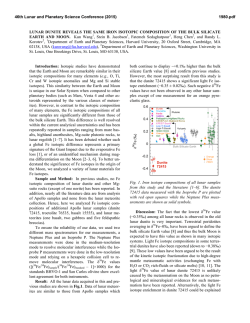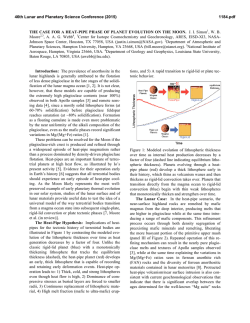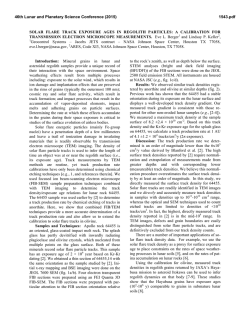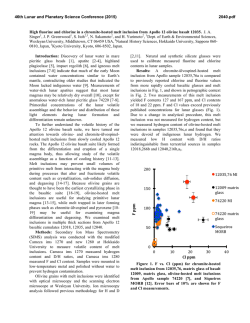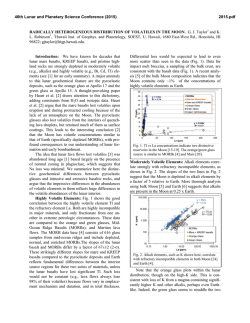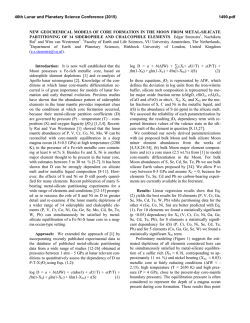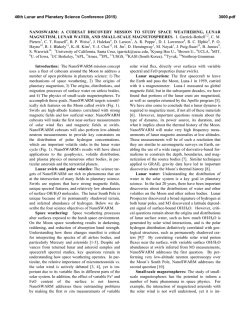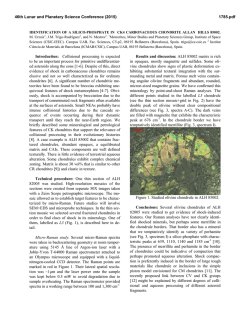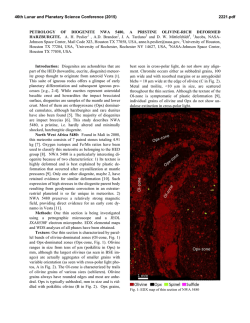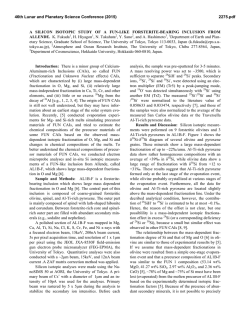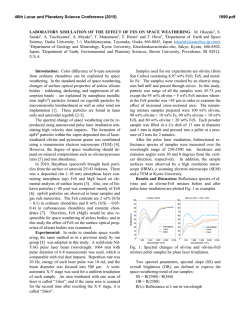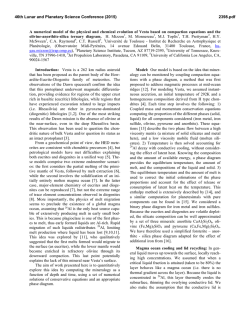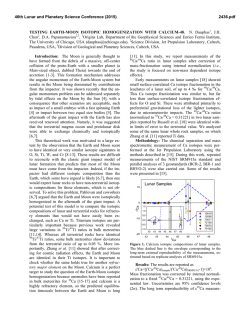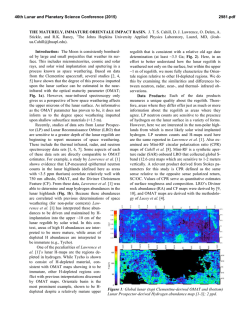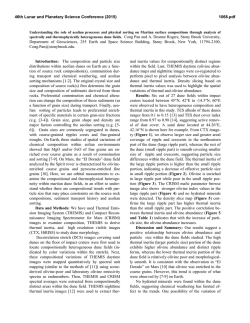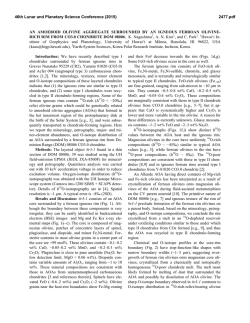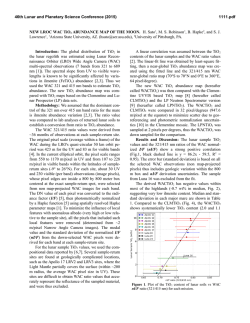
REMOTE DETECTION OF MAGMATIC WATER IN ASSOCIATION
46th Lunar and Planetary Science Conference (2015) 1396.pdf REMOTE DETECTION OF MAGMATIC WATER IN ASSOCIATION WITH OLIVINE OF POSSIBLE MANTLE ORIGIN ON THE MOON. Satadru Bhattacharya, Mamta Chauhan and Prakash Chauhan, Space Applications Centre, Indian Space Research Organisation, Ahmedabad – 380 015, India ([email protected]). Introduction: The recent studies on Moon strongly reveals its hydrous nature [1]. In-situ measurements of Lunar volcanic glasses, olivine-hosted melt inclusions, apatite and anorthosites further indicate parts of the deep lunar interior to be hydrated [2-5]. Also, a global hydration feature was observed on the Moon [68] based on recent orbital measurements, which could be attributed mostly to the exogenic processes [9]. Recently, water of possible magmatic/endogenic affinity has been reported from the Compton Belkovich volcanic complex (CBVC) [10, 11] and the central peak of Bullialdus crater [12]. Subsequently, similar hydration feature of probable magmatic origin has also been reported from the northern inner rim of Sinus Iridum [13] and the central peak of Jackson crater [14] pointing strongly towards the existence of a hydrous lunar mantle. Olivine is not only an important constituent of lunar mantle but also present in a significant amount in many lunar basalts and mafic plutonic rocks such as dunite, troctolites, norites and gabbronorites, popularly known as Mg-suite of rocks. Recently, olivine-bearing lithologies have been detected at central peaks and crater rims of various complex craters and large impact basins respectively [15]. Olivine is also extremely important as it can trap the samples of primitive lunar magma in the form of lunar melt inclusions. Being trapped within the olivine crystals before volcanic eruption, these melt inclusions suffer minimum posteruptive degassing and therefore contain maximum amounts of magmatic water and other volatiles, the amounts of which matches very closely to primitive terrestrial mid-ocean ridge basalts [3]. The present study aims at remote detection of magmatic water in association with olivine from different parts of the Moon. Datasets and Methodology: Data from Moon Mineralogy Mapper (M3) instrument aboard Chandrayaan-1 have been used with 85 spectral channels covering a spectral range of ~460-3000 nm collected in five different optical periods [16, 17]. Photometrically and thermally corrected Level-2 (Global Mode) data [16, 17] were used for the present study. Spectra were collected from relatively immature areas and their stability across optical periods have been studied. Results and Discussions: Figure 1 shows the locations of the study areas. Previous studies [15] have reported the presence of olivine that are possibly of mantle origin from the areas showin in Figure 1, which include Sinus Iridum, Theophilus, Copernicus, Aristarchus and Aristotels craters from the near side and Mare Figure 1. Locations of olivine exposures associated with hydroxyl anomaly on the Moon. Mare Moscoviense is shown with a white arrow pointing towards the far side. Moscoviense from the far side. Here we report the presence of enhanced hydration feature associated with the spectra of mineral olivine from the above mentioned areas. The continuum-removed spectra collected from the study areas show a characteristic composite band of olivine near 1030 nm followed by a sharp hydration feature at around 2800 nm as shown in Figure 2. The band strength of the hydration feature associated with olivine ranges on an average from ~4-6%. Most of the olivines in these study areas are characterized by the complete absence of a 2000-nm pyroxene and/or spinel feature except for those from Aristotels, Copernicus and Mare Moscoviense. Aristoteles is an exception in a sense that it possibly contains chromite with olivine as can be inferred based on the presence of a prominent feature around 2200 nm [18, 19]. The olivine at Sinus Iridium and Mare Moscovience occurs in association with orthopyroxene and Mg-spinel characterizing a lower crust or mantle lithology (OOS) and the exposures are mostly confined to the inner ring of the basin [13, 20]. The olivine exposures at the other complex craters, namely Aristoteles [18, 19], Theophilus [21, 22], Aristarchus [23] and Copernicus [24] are dunitic/troctolitic in nature. The unique tectonic setting of these complex craters and their young age and associated thin crust are indicative of their deep seated origin [15, 24] and thus, the associated hydration feature is also suggestive of a possible deeper magmatic source. However, a detailed study involving 46th Lunar and Planetary Science Conference (2015) very high spatial resolution data is needed to understand the nature of olivine exposures at the above mentioned locations, with which prominent hydration features are associated. Analytical studies showed that the melt inclusions in olivine are ideal samples to estimate the pre-eruptive volatile content of the magma as magmatic water is trapped within the crystals that grow before eruption [3]. While the water content of pyroclastic glasses is modified by cosmic-ray spallation and magmatic degassing, the melt inclusions being enclosed in the host crystal are protected from loss of volatiles by degassing during magma eruption and thus, are least prone to post-eruptive degassing and loss of volatiles [3, 25]. Also, the lunar sample belonging to lunar highland of alkali-suite and Mg-suite group, are the better candidates to reveal the amount and origin of water at the time of the Moon’s formation as they are the earliest products of LMO crystallization in contrast to the later LMO products, namely, mare basalts and pyroclastic lunar glasses [26, 27]. Approximately 270-1200 ppm of water have been measured in melt inclusions trapped in olivine crystals of high-Ti pyroclastic glass beads through direct analysis of the volatiles using NanoSIMS [3]. The present study has important implications for understanding the relation between the olivine and the associated hydrous feature in the remotely sensed spectra, which in turn will help in understanding the hydrous nature of lunar mantle and the heterogeneous distribution of endogenic water in the deep lunar interior. These observation results along with laboratory based analytical study of returned samples can enhance our knowledge about the various aspects of lunar hydration processes associated with varied lithology, morphology and geological setting on the Moon. 1396.pdf References: [1] Hauri E. H. (2015) EPSL 409, 252–264. [2] Saal A. E. et al. (2008) Nature 454, 192– 195. [3] Hauri E. H. et al. (2011) Science 333, 6039, 213-215. [4] McCubbin F. et al. (2010) Proc. Nat. Acad. Sci. USA 107, 11223–11228. [5] Hui et al. (2013) Nat. Geosci. 6, 177–180. [6] Pieters C. M. et al. (2009) Science 326, 568-571. [7] Clark R. N. et al. (2009) Science 326, 562-564. [8] Sunshine J. M. et al. (2009) Science 326, 565-568. [9] McCord T. B. et al. (2011) JGR 116, E00G05. [10] Bhattacharya S. et al. (2013) Curr. Sci. 105, 5, 685-691. [11] Petro N. et al. (2013) LPS XXXXIV, Abstract #2688. [12] Klima R. et al. (2013) Nat. Geosci., doi:10.1038/ngeo1909. [13] Bhattacharya S. et al. (2014) LPS XXXXV, Abstract #1816. [14] Chauhan P. et al. (2014) LPS XXXXV, Abstract #2072. [15] Yamamoto S. et. al. (2010) Nat. Geosci. 3, 533 – 536. [16] Boardman J. et al. (2011) JGR. 116, E00G14. [17] Clark R. N. et. al. (2009) JGR. 116, E00G16. [18] Bhattacharya S. et al. (2014) LPS XXXXV, Abstract #1845. [19] Chauhan M. et al. (2015), this volume. [20] Pieters C. M. et al. (2011) JGR 116, E00G08. [21] Dhingra D. et al. (2011) GRL 38, L11201. [22] Lal D. et al. (2012) JESS 121, 3, 847853. [23] Mustard J. F. et al. (2011) JGR 116, E00G12. [24] Pieters, C. M. (1982) Science 215, 4528, 59-61. [25] Saal A. E. et al. (2013) Science 340, 1317-1320. [26] Barnes J. J. et. al. (2014) EPSL 390, 244-252. [27] McCubbin F. M. (2011) GCA 75, 5073-5093. Figure 2. Continuum-removed spectras of the olivine with associated hydrous feature (at 2800nm) acquired from various locations on the Moon. a) Sinus Iridium, b) Copernicus, c) Theophilus, d) Aristarchus, e) Moscovience, f) Aristoteles.
© Copyright 2025
